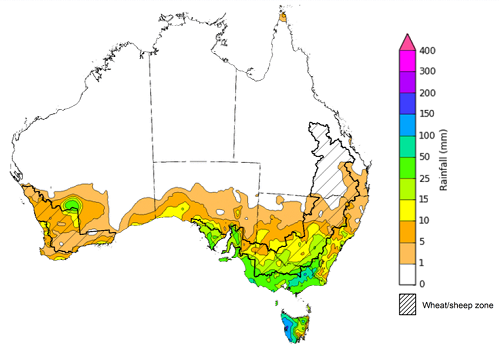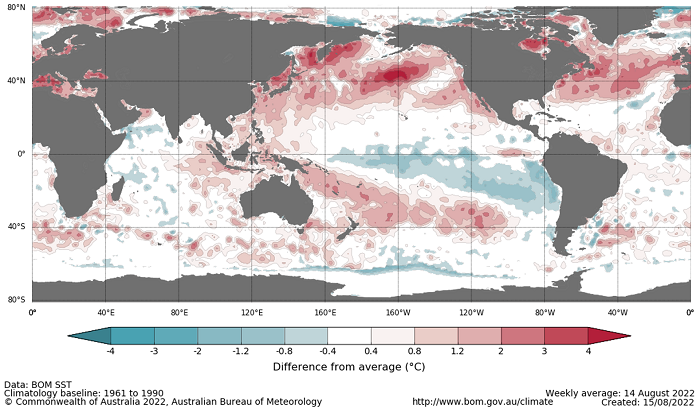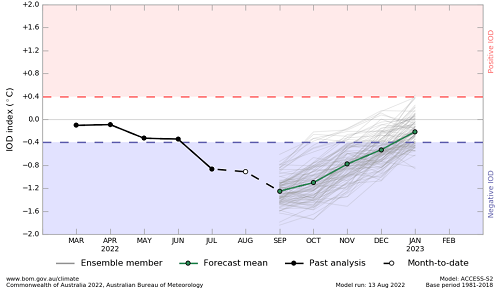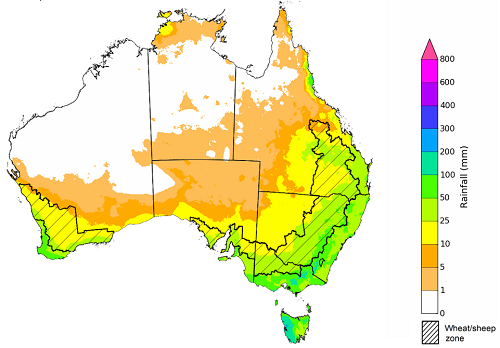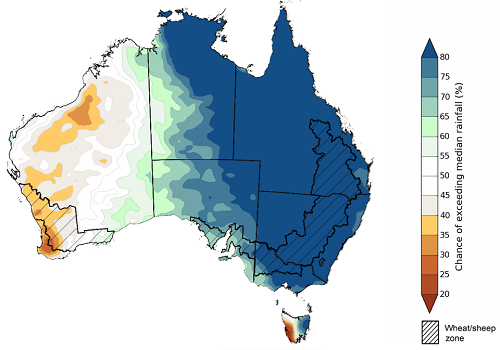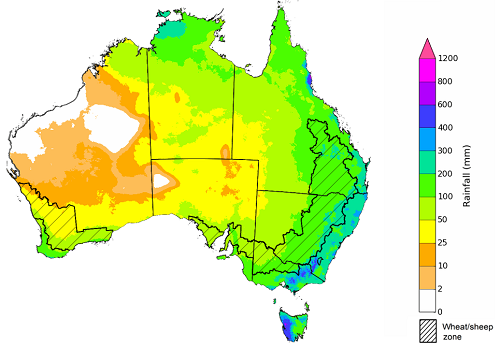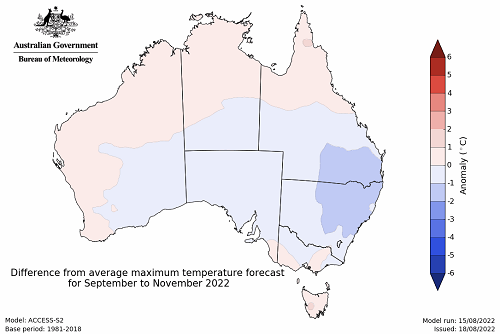Key issues
- For the week ending 24 August 2022, cold fronts off the Southern Ocean brought moderate to heavy rainfall across south-eastern Australia. Meanwhile, high-pressure systems over remaining parts of the country resulted in clear, dry conditions.
- Rainfalls across southern New South Wales, Victoria and South Australia consolidate the falls received over the previous week, improving soil moisture levels to average to above average across the south-east. Meanwhile, the mostly dry conditions in Western Australia have reduced the risk of waterlogging, following two weeks of moderate rainfall. For northern New South Wales and southern Queensland, dry conditions over the past week have allowed soil moisture levels to also subside, reducing the risk of waterlogging.
- The El Niño–Southern Oscillation (ENSO) is currently neutral. However, the Australian Bureau of Meteorology has recently raised its ENSO Outlook to La Niña ALERT, with a 70% likelihood of a La Niña event forming over the coming months (triple the normal probability). A negative Indian Ocean Dipole (IOD) event is established in the tropical Indian Ocean, and the Southern Annular Mode (SAM) is currently neutral. Given current and expected conditions, the negative IOD event and the development of a La Niña event are likely to be the major influences on spring rainfall across Australia.
- The outlook for September 2022 indicates that there is a 75% chance of rainfall totals between 10 and 50 millimetres across much of New South Wales, south-eastern and parts of north-eastern Queensland, Victoria, southern South Australia, the south-west of Western Australia, Tasmania and isolated parts in the north of the Northern Territory. Rainfall totals in excess of 100 millimetres are expected across alpine regions of New South Wales and Victoria, as well as western Tasmania.
- Over the 8-days to 1 September 2022, troughs, low pressure systems and cold fronts are forecast to bring light to moderate rainfall to areas across central and eastern Australia. Across the remainder of the country, high-pressure systems will persist, providing clear, dry conditions. The light to moderate rainfall forecast for cropping regions in southern New South Wales will benefit winter crops where soil moisture levels are currently below average to average. Light to moderate rainfall forecast for northern New South Wales and Queensland cropping regions are not expected to increase the risk of waterlogging but may further restrict field access in the coming week.
- Water storage in the Murray–Darling Basin (MDB) increased by 162 gigalitres (GL) between 17 August 2022 and 24 August 2022. The current volume of water held in storage is 23,193 GL, which represents 92% of total capacity. This is 14% or 2,774 GL more than at the same time last year.
- Allocation prices in the Victorian Murray below the Barmah Choke decreased from $78 per ML on 5 August 2022 to $75 per ML on 12 August 2022. Prices are lower in the Murrumbidgee, Goulburn-Broken and regions above the Barmah choke due to the binding of the Murrumbidgee export limit, Goulburn intervalley trade limit and Barmah choke trade constraint.
Climate
For the week ending 24 August 2022, cold fronts off the Southern Ocean brought moderate to heavy rainfall across south-eastern Australia. Meanwhile, high-pressure systems over remaining parts of the country resulted in clear, dry conditions.
Rainfall totals of between 10 and 50 millimetres were recorded across much of southern New South Wales, Victoria, the south of South Australia, isolated parts of south-west Western Australia, as well as eastern Tasmania. Rainfall totals in excess of 50 millimetres were recorded in alpine areas of New South Wales and Victoria, isolated parts of south-east South Australia and western Tasmania. Remaining parts of Australia received little to no rainfall.
In Australian cropping regions, rainfall totals of between 10 and 50 millimetres were recorded across southern New South Wales, much of Victoria and South Australia, as well as isolated parts of Western Australia. Little to no rainfall was recorded across remaining cropping regions for the week ending 24 August 2022.
Rainfalls across southern New South Wales, Victoria and South Australia consolidate the falls received over the previous week, improving soil moisture levels to average to above average across the south-east. Meanwhile, the mostly dry conditions in Western Australia have reduced the risk of waterlogging, following two weeks of moderate rainfall. Winter crops across southern and western cropping regions have experienced favourable conditions thus far in the season. Timely planting for most growers and sufficient rainfall throughout the first half of the season has established good yield potentials. However, frost events and wet conditions as crops mature present the largest downside risks.
For northern New South Wales and southern Queensland, dry conditions over the past week have allowed soil moisture levels to subside, reducing the risk of waterlogging. Yield potentials remained mixed across these cropping regions. Late planted and waterlogged crops have struggled to establish significant biomass heading into spring, while crops planted in a timely manner have largely benefited from the wet conditions.
Rainfall for the week ending 24 August 2022
Throughout the late winter and early spring period the climate drivers with the largest potential impact on Australia’s climate patterns are the El Niño–Southern Oscillation (ENSO), the Indian Ocean Dipole (IOD) and the Southern Annular Mode (SAM). These climate drivers are likely to influence pasture growth across southern Australia and the growth and yield prospects for winter crops.
The ENSO is currently neutral. However, the Australian Bureau of Meteorology has recently raised its ENSO Outlook to La Niña ALERT, with a 70% likelihood of a La Niña event forming over the coming months (triple the normal probability). Sea surface temperatures over the tropical Pacific have cooled over recent weeks, while some atmospheric indicators, such as the Southern Oscillation Index and Pacific trade winds have maintained a La Niña-like pattern. A negative IOD event is established in the tropical Indian Ocean, and the SAM is currently neutral. Given current and expected conditions, the negative IOD event and the development of a La Niña event are likely to be the major influences on spring rainfall across Australia.
Sea surface temperature (SSTs) anomalies in the tropical Pacific Ocean close to the equator have been cooler than average across much of the equator, with cool anomalies strengthening in over the last two weeks. were slightly cooler than average over much of the tropical central and eastern Pacific south of the equator. A small pocket of weak warm anomalies remains in the eastern Pacific along the equator. Below average Pacific equatorial sea surface temperatures are associated with La Niña conditions.
Warm sea surface temperature anomalies continue across the eastern Indian Ocean and the southern Maritime Continent, while cool anomalies are present near the Horn of Africa and the north-west of the Indian Ocean basin. The temperature gradient established across the tropical Indian Ocean underpins the ongoing negative IOD event.
Difference from average sea surface temperature observations 8 August to 14 August 2022
International climate model outlooks for the NINO 3.4 region in November 2022
Five of the seven international models surveyed predict the formation of a La Niña event in November 2022, which is underpinned by atmospheric and oceanic indicators. For the period ending 14 August, the 30 day Southern Oscillation Index (SOI) value was 11.0 and the 90 day value was 13.9, both of which are above the La Niña threshold of +7. La Niña events are associated with above average rainfall across eastern and northern Australia through spring and summer.
30-day Southern Oscillation Index (SOI) values ending 22 August 2021
A negative IOD event is underway, with values exceeding the negative IOD threshold (−0.4 °C) since mid-June. Warmer than average water temperatures in the east of the Indian Ocean and cooler than average temperatures in the west are associated with above average rainfall across southern Australia throughout winter and spring, as well as the far north. It is also associated with the early onset of northern Australia rainfall.
As at 14 August 2022, the Indian Ocean Dipole (IOD) weekly value was -1.15°C. All international climate models surveyed by the Bureau of Meteorology predict the negative IOD event to persist until November, then rapidly decay in December.
Monthly sea surface temperature anomalies for IOD region
These climate outlooks are generated by ACCESS–S (Australian Community Climate Earth-System Simulator–Seasonal). ACCESS–S is the Bureau of Meteorology's dynamic (physics-based) weather and climate model used for monthly, seasonal and longer-lead climate outlooks.
For further information, go to http://www.bom.gov.au/climate/ahead/about/
The Bureau of Meteorology’s latest rainfall outlook indicates wetter than average conditions are expected across most of Australia during September. The ACCESS-S climate model suggests there is close to a 60% chance of exceeding median for parts of eastern, central and much of western Australia, with below median rainfall likely for the south-west of Western Australia and western Tasmania.
The outlook for September 2022 indicates that there is a 75% chance of rainfall totals between 10 and 50 millimetres across much of New South Wales, south-eastern and isolated parts of north-eastern Queensland, Victoria, southern South Australia, the south-west of Western Australia, Tasmania and isolated parts in the north of the Northern Territory. Rainfall totals in excess of 100 millimetres are expected across alpine regions of New South Wales and Victoria, as well as western Tasmania.
Across cropping regions there is a 75% chance of rainfall totals of between 25 and 50 millimetres across much of New South Wales, Victoria, central and south-eastern Queensland, central South Australia and isolated parts of Western Australia. There is a 75% chance of rainfall less than 25 millimetres for the northwest of Victoria, parts of eastern and western South Australia, northern and south-western Queensland, and central and eastern cropping regions in Western Australia. These falls are likely to be sufficient to support the current yield potential of winter crops and average or better pasture growth potential, given average to above average soil moisture level across most southern Australian growing regions.
Rainfall totals that have a 75% chance of occurring September 2022
The rainfall outlook for September to November 2022 suggests there is a greater than 75% chance of exceeding median rainfall across most of New South Wales, Queensland, Victoria, and eastern South Australia and the Northern Territory. For remaining regions of Australia, there is no strong tendency towards above or below median rainfall, except for parts of north-western and south-western Western Australia and south-western Tasmania where below median rainfall is likely between September to November 2022 (Bureau of Meteorology ‘National Climate Outlook’, 18 August 2022).
Bureau of Meteorology rainfall outlooks for September to November have greater than 55% past accuracy across most of eastern and central Australia. Outlook accuracy is greater than 65% across large areas of New South Wales, Victoria and parts of Queensland. Past accuracy is low (less than 50%) for western and southern parts of Western Australia.
Chance of exceeding the median rainfall September to November 2022
The outlook for September to November 2022 suggests there is a 75% chance of rainfall totals between 50 and 200 millimetres across Victoria, most of New South Wales and Queensland, southern parts of South Australia, the south-west and far north of Western Australia, Tasmania and the north and centre of the Northern Territory. Rainfall totals in excess of 200 millimetres are forecast for eastern New South Wales and Victoria, scattered areas of eastern Queensland, the far north of the Northern Territory and western Tasmania.
Across cropping regions, there is a 75% chance of receiving between 50 and 100 millimetres across, north-western Victoria, much of South Australia and southern parts of Western Australia. Totals of between 100 and 200 millimetres are expected across much of New South Wales and Queensland, southern Victoria and central South Australia.
The high probability of above average rainfall across eastern and southern cropping regions through spring is likely to provide mixed results. For much of southern New South Wales, Victoria and South Australia, where winter crops were planted in a timely manner and conditions have been favourable thus far, above average rainfall and mild temperatures will support strong yield development through spring. However, above average rainfall across central and northern New South Wales and Queensland is likely to exacerbate waterlogging issues, contribute to the leaching of fertilizers and impede crop development. These all present a potential downside risk of realising current strong crop yield predictions. However, for regions that avoid waterlogging issues, the rainfall will improve yield potentials. If realised, the near-average rainfall outlook for Western Australia through spring should be sufficient to support winter crops through critical development stages, and setup winter crops for strong yields.
Rainfall totals that have a 75% chance of occurring September to November 2022
Predicted maximum temperature anomaly for September to November 2022
Predicted minimum temperature anomaly for September to November 2022
Over the 8-days to 1 September 2022, troughs, low pressure systems and cold fronts are forecast to bring light to moderate rainfall to areas across central and eastern Australia. Across the remainder of the country, high-pressure systems will persist, providing clear, dry conditions.
Rainfall totals of between 10 and 50 millimetres are forecast across central and northern New South Wales, southern and eastern Victoria, southern and north-eastern Queensland, eastern and northern Tasmania, and scattered areas of central Western Australia and the Northern Territory. Rainfall totals in excess of 50 millimetres are forecast for parts of north-eastern Queensland. Little to no rainfall is forecast across remaining parts of Australia over the next 8-days.
In Australian cropping regions, rainfall totals of between 10 and 50 millimetres are expected across much of New South Wales, Queensland and eastern Victoria. Little to no rainfall is forecast for cropping regions in south-western New South Wales, western Victoria, South Australia and Western Australia during the next 8-days.
The light to moderate rainfall forecast for cropping regions in southern New South Wales will benefit winter crops where soil moisture levels are currently below average to average. Across southern cropping regions, rainfall received over the past weeks has consolidated yield potentials. However, further rainfall will be required as we enter spring. The dry conditions expected across Western Australia will allow soil moisture levels and the risk of waterlogging to subside.
Light to moderate rainfall forecast for northern New South Wales and Queensland cropping regions are not expected to increase the risk of waterlogging but may further restrict field access in the coming week. Overall, yield prospects across major cropping regions look very favourable for this point in the season. However, the most sensitive periods for yield development (flowering and grain filling) are yet to come. A lack of plant available moisture and frost damage during these periods would negatively impact the production outlook. Growers in Queensland will also be looking to start field preparation over the coming weeks for planting of summer crops in September.
Total forecast rainfall (mm) for the period 25 August to 1 September 2022
Water
Water storages, water markets and water allocations - current week
The Tableau dashboard may not meet accessibility requirements. For information about the contents of these dashboards contact ABARES.
Commodities
Information on weekly price changes in agricultural commodities is now available at the Weekly commodity price update.

